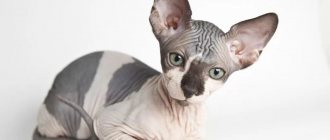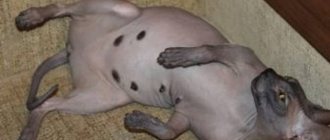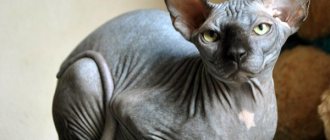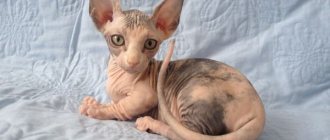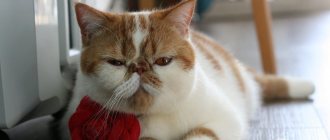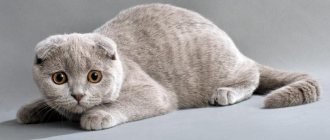Grooming cats is a newfangled invention that has received a large number of fans and opponents. Veterinarians are against such excesses and are confident that you can cut your pet’s hair only when necessary, and not for your own pleasure. Animals do not react well to imposed changes; they may become depressed, hide from their owner for a long time, or begin to take revenge.
Why do pets get haircuts? Why is hair cutting and shaving of cats not recommended by experts? What consequences can result from ignoring the opinion of veterinarians?
Haircut frequency
The frequency of haircuts is affected by the cat's coat type and breed. The fur on an animal completely grows back in an average of six months. Veterinarians recommend grooming long-haired and fluffy cats for hygienic purposes 3-4 times a year. For other types, 1-2 haircuts per year are enough. Cats are groomed before the hot days begin, so the cat can better withstand the heat.
Don't be too zealous in this matter. Wool serves as a natural protection for your pet, which is especially important during the cold season.
The cutting time should also coincide with the beginning of shedding. It’s not difficult to verify this simply by pulling the cat’s fur. The remaining hairs in the hand indicate that shedding has begun.
Breeds that often need grooming
Typically, cats of semi- and long-haired breeds suffer the most from matting and the formation of tangles. Even if you miss even one brushing, for example, of a Persian, problems will definitely arise. The animal's blood circulation is impaired due to skin tightness, it becomes nervous, experiences discomfort and itching.
Therefore, most often, haircuts to remove tangles are used for:
It should be remembered that Persians have hair in the undercoat and the main coat of the same length, and cutting for this truly long-haired breed does not disrupt heat exchange. Therefore, the grooming procedure is not dangerous for their health. But the semi-long-haired Maine Coon, Siberian and Norwegian forest cats have axial and undercoat hair of different lengths. Due to this, a layer of air is naturally created, protecting the pet from overheating and excessive cooling.
The texture and structure of the hairs here are also different, so cutting these breeds must be done very carefully and only as a last resort.
Short-haired breeds usually do not require trimming at all. The only exception is the British.
It is easier to prevent the formation of tangles than to cut them off later, ruining the aesthetic appearance of your pet. Moreover, you should not subject him to a more beautiful general haircut, disrupting the heat exchange of the skin and causing unnecessary risks to the cat’s health.
What tool is needed for cutting
Grooming cats is done with two tools - a clipper and scissors. A nice and neat haircut can be achieved by alternating both tools in different areas. It is convenient to use scissors to trim what is left after the device. Cutting long hair with scissors is time-consuming and traumatic, and the result is not always neat.
Select scissors of medium size with sharp edges and rounded ends. The machine does not injure the cat, it is comfortable to work with and will require less time. My only wish is to choose a model with minimal noise so as not to frighten your pet. When working with a human machine, it is difficult to achieve straight lines. It is better to purchase a special device. For long and thick wool, its power should be at least 45 W.
To groom cats that are afraid of noise from the device, you can try a mechanical clipper. Handling it requires a certain skill so as not to injure your pet.
Additionally, for a haircut you will need:
- Fine-tooth comb
- Hydrogen peroxide for skin cuts
- A place for cutting, such as a small table
- An old towel as a bedding to collect the wool in and throw away
- Cat entertainment toy
Mechanical hair clipper
Necessary accessories and preparation for a haircut
If, nevertheless, there is an urgent need to groom a cat, but the owner is afraid of injuring the pet and is not sure that he can cope with the procedure, you can contact grooming specialists in a professional salon. This operation is also included in the price list of many veterinary clinics.
In case of self-grooming at home, the animal owner must first purchase the necessary tools and equipment and perform certain actions:
- Prepare a table or wide ironing board as a grooming area.
- Buy large and small scissors with rounded tips and sharp blades made of high-quality steel, a furminator.
- Choose and buy a trimmer - a special machine for cutting animals. The optimal nozzle for cats is usually 3 mm. The device cannot be used on human hair, as cats have a completely different hair structure. You also need to decide on the power of the device, so for Persians it needs high (45-60 W), for semi-long-haired pets you can limit yourself to 20 W.
- Make sure there is minimal stress for the cat. Thus, more powerful rotary trimmers make a lot of noise and frighten the animal; it is worth choosing a model with a mains adapter and a vibration-type motor.
- The cat may need to be given sedatives the day before the procedure. It should be remembered that synthetic substances and anesthesia will harm your pet; it is better to use herbal products.
- Sometimes it is advisable to use an Elizabethan collar - a special device worn around the animal’s neck. It can prevent a nervous cat from biting and injuring the groomer. A special muzzle can also help - a cap that covers the cat’s mouth and eyes.
- Most likely, you will need a special machine for cutting hair on the paw pads, face, around the genitals, and in other hard-to-reach places.
- It is necessary to provide thinning scissors and a massage brush to bring the hairstyle to its final shine. Also, for some (especially short-haired breeds) cats, you will need velvet for polishing, wet wipes to remove excess hair, or a special glove.
- It is also worth making sure that you have on hand the means to provide first aid to your pet if an accidental injury to the skin occurs. It is better not to use alcohol-containing compounds (iodine), but to purchase hydrogen peroxide, Miramistin, Chlorhexidine, and special talc.
Useful tips
To cut your cat's hair yourself, you need to know the subtleties:
- You cannot cut the hair on the cat’s head, on the pads, in the ears, or shorten the whiskers. Cut hair on a pet's head can disrupt its spatial orientation. The fur in the ears performs a protective function against the penetration of dust and foreign bodies.
- Sometimes after a haircut, the coat changes structure and shade. It may become darker or lighter.
- Please note that the length of the regrown coat may be shorter than the previous one.
- The haircut process is quite long and labor-intensive. If you do not have such experience, you should expect 2-3 hours.
- It is recommended to use the machine on dry skin. When using scissors, the fur is slightly moistened and combed, then it will be easier to deal with vegetation.
- Cats should not be cut too short. A few millimeters should remain to maintain natural thermoregulation and avoid skin damage.
- The owner shouldn't worry. His condition is transmitted to the animal and can easily provoke stress. The cat will begin to struggle and scratch.
- Nervous animals are easier to trim their fur. The hair will remain longer and the cat will worry less. Haircut against the grain greatly irritates your pet.
- To alleviate nervousness, it is recommended to cut your hair in several approaches. During breaks, stroke and soothe in every possible way.
- Cats have a hard time reacting to outbursts of emotion during or after grooming. This should be avoided and not made fun of by the haircut.
Origin story
Brush during molting period.
The official ancestor of this breed is a cat that was rescued in 1987 from the hands of street hooligans. This was a respectable act done by professor of the Pedagogical Institute E. Kovalev. This animal does not have hair on certain parts of the body. Soon she became completely bald. Veterinarians and the cat's owner explained this by shock or the consequences of a previous illness. After some time, the cat gave birth to new kittens, which initially looked like their mother. These kittens were mistakenly recognized as sick and for this reason they were killed, except for one.
The origin of the Don Sphynx Brush began with this kitten. During the formation of the breed, Brushes were crossed with shorthaired breeds. Today the gene pool of the breed is fully formed and pure. In 1996 they received recognition from the World Cat Federation or WCF. They received their own standard of appearance and an accurate description of their appearance. Today this breed takes part in many international cat shows, competitions and other events in the world of felinology.
Grooming a cat at home
You need to prepare for the haircut process. First, armed with special tweezers, trim the cat’s nails. The instrument must be disinfected. Grasp the pad on your paw and squeeze it lightly. Quickly and carefully shorten the claws without touching the skin. This will ensure safety in case of animal aggression.
For the first haircut, you will need an assistant to hold your pet's sides. Cats often behave very aggressively. Therefore, the clinic must purchase a plastic collar in advance. It will fix the head in a constant position and the cat will not be able to bite. In any case, the paws must be held.
A stationery clip on the back of the neck helps calm the cat. In extreme cases, violent animals are given inhibitory or sleeping pills. You should not use them yourself, so as not to harm your pet.
Holding the pet
Haircut process
Before turning on the machine, the cat is placed on its side and its limbs are fixed. Using leisurely and careful movements, remove the hair on the sides. After this, they proceed to the back and stomach. Cats can be groomed according to hair growth or against it.
If there are tangles, cut them off first. To accustom the cat to the sound of the machine, it is turned on in the distance. The cat adapts to the noise and after some time you can begin. It is recommended to install a nozzle of at least 3 mm. Moving the machine without an attachment severely injures the skin.
The stomach is the most delicate area and requires special attention. This is where the mammary glands and intimate area are located, and it is important not to injure them.
At the end of the haircut, it is better to cut off the remaining hairs with scissors. Moving the machine over the skin will cause discomfort and microtrauma. At the cutting site, the skin should be pulled back slightly to avoid cuts. Especially when working with scissors.
The tail and paws are most often not cut, but they can also be shaved. Just leave a small brush at the tip of the tail. A cat may not recognize a naked tail and will bite it, causing pain to itself.
When doing a haircut, you need to be more gentle and talk to the cat. Then the unpleasant procedure will pass quickly and painlessly.
In what cases is it contraindicated?
Experts note the three weakest areas, where hair removal can be dangerous for your pet:
- Paws, especially their lower part
- Tail, but model treatment of the last third of the organ is allowed
- head
Experts have an extremely negative attitude towards total haircuts. The optimal hair length, if you really want or need treatment, is 0.5 - 1 cm. The hair will no longer bother the owners, and the protective layer is preserved.
The naked animal should be covered with a cotton cloth to avoid direct exposure to sunlight. This will avoid burns or prevent the development of cancer.
It is important to understand that the lack of hair can negatively affect a cat's psyche and communication. Apathy, loss of appetite, ignoring the owners are not uncommon situations after a total haircut.
In addition, wool is one of the main tools in the fight for territory or a female. A naked animal may simply not be perceived by competitors. The situation is especially relevant for owners of private houses. A cat that has lost a war for territory several times will be afraid of its rivals, “invite” it to visit and even share food. Often the neighbor's cat will completely take the loser's food away.
IMPORTANT! Due to hypothermia after cutting, in some places the hair often does not grow back. You should carefully monitor your pet's heat exchange, especially in winter and autumn.
How to care for a cat after a haircut
After the process is completed, the cat needs to be combed. This will remove any cut hairs remaining on it. Then buy cat shampoo in warm water.
It is recommended not to bathe a nervous or excited animal, but to wipe it with a damp towel. This way the pet’s psyche will be less traumatized. For cats that are not afraid of the noise of a hair dryer, it is recommended to dry their fur. The air should be warm. There is no need to turn on hot air so as not to provoke additional stress.
Combing the animal
Is it possible to shave a cat's head?
Animal wool plays a big role: it protects against hypothermia, sun rays, and protects the skin from accidental damage. Cats that are constantly kept indoors are no less susceptible to injury than street cats.
Shaving the head is strictly prohibited: sensitive vibrissae are located here, damage to which is contraindicated. Hair cutting bald is an extreme measure, permissible if it is impossible to remove building mortars and foam from the coat, and it is also necessary before surgery. In other cases, shaving your pet will not bring any benefit, but can cause the development of colds.
In addition to the above, it is unknown how long the wool will take to recover. This usually happens within six months, but if there is a lack of nutrients, the process can drag on for several years.
How to speed up the process
A cat's fur, like that of any other animal, goes through 3 stages of growth:
Hair reaches a certain length. Then its development stops and, after a certain time, the hair falls out, giving way to a new one. The cut pile is mainly in a catagen state. An exception would be a haircut to zero, when the developing hairs are also cut off.
Most of the fur coat will not grow back. Fresh anagen hairs will form a new coat after the cat is groomed. How quickly wool grows depends on a number of factors:
- Diet. To speed up the restoration of “hair”, your pet needs proteins. Experts recommend that their share per dry weight be at least 30%. Hair growth is also stimulated by zinc, vitamins and fatty acids. The cat can receive them with food (meat, cooked yolk, sea fish) or nutritional supplements.
Ambient conditions. In nature, animals grow overgrown before frost and molt with the arrival of warmer weather. Cats living in the house are less affected by this cycle, but the connection remains. Wool grows faster in spring and summer. In winter, the process of hair change slows down. By deciding to cut your pet's hair during the warm season, the owner will quickly see his original fur coat. This is a practical solution - animals shed less during the cold season.
Care. Regular combing stimulates hair change. It is also necessary to monitor your pet's stress level. A nervous cat may shed a lot. In this case, new follicles are not activated. If the source of stress persists, the coat thins, even to the appearance of bald patches.
The fur has grown back faster, you need to provide the cat with proper nutrition. You should not imitate warming - too high a room temperature will cause molting, but will not awaken the follicles.
Overheating will also negatively affect the health of your pet and other residents. It is better to cut it in the warm season, with natural accelerated hair change. Although, during the cold season, the hairstyle will last longer.
Why do cats need to be trimmed? What kind of service is this?
A similar service is provided by grooming salons and veterinary clinics. In order to trim a cat, there must be medical or other indications. Strong arguments in favor of the procedure will be:
- You or someone in your household is allergic to cat fur. In this case, it is advisable to use the service to prevent close contact with the allergen.
- The cat is about to undergo a procedure or surgery. Often, hair needs to be removed locally, and this is done directly at the veterinary clinic
- The pet is too hot in a room that cannot be cooled. However, it is worth remembering that the body of cats is very sensitive to temperature changes, so you need to make sure that after the procedure the temperature in the apartment or house will be maintained at the proper level
- The presence of skin diseases in a pet, when hair interferes with effective treatment
- If your cat swallows a lot of hair. This can cause serious problems with the gastrointestinal tract and digestion.
If this is not necessary, then it is better not to expose your cat to such a risk. These animals do not tolerate haircuts well; it can weaken their body and cause stress.
This is interesting: How to calm a cat at night?
What determines the price of the procedure?
Prices vary and depend primarily on the salon itself. In some you will pay only 1000 rubles , while others ask for 3-4 thousand . The purpose of the service also plays an important role. Hygienic and medical haircuts are usually cheaper, while model haircuts can cost up to 10,000 rubles . The nature and length of your pet’s fur will also play a role, and you need to pay attention to the presence of tangles in the cat, which also increase the cost of the procedure.
This is interesting: Metrogyl denta for cats

